Learn
Polygons
As we begin the lesson on polygons, we must first understand the vocabulary used with two-dimensional figures.
We will then study in depth the polygon with the least number of sides possible in order to understand the properties of polygons with more sides.
Vocabulary
- polygon
- vertex
- side
- diagonal
- convex
- concave
- n-gon
- equilateral polygon
- equiangular polygon
A polygon is a closed figure with a finite number of sides which are line segments.
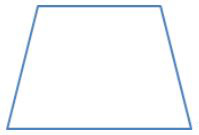
An angle formed by the intersection of two sides is called a vertex of the polygon.
A polygon has to meet the following three criteria:
- a polygon must have at least three sides
- all sides must be line segments
- each side intersects exactly two other sides, one at each endpoint
Not Polygons

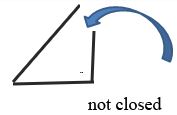
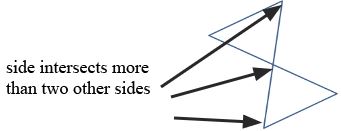
Parts of a Polygon
Below is an example of a polygon. Remember each endpoint is called a vertex. Plural for vertex is vertices. We would say this polygon has four vertices. You name a polygon by listing the vertices consecutively. It does not matter which endpoint you start with or if you go clockwise or counterclockwise rotation. We could name the polygon above as polygon ABCD or ADCB and still be correct.
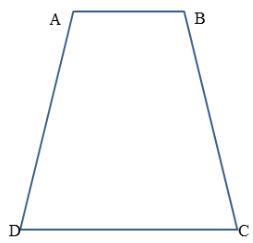
Convex Polygons
Diagonals are helpful in determining if a polygon is convex or concave. A polygon is considered convex if none of the diagonals of the polygon are outside of the figure.
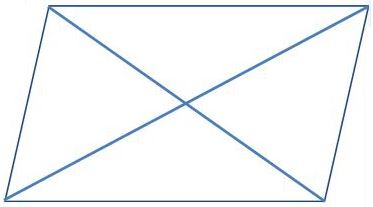
Concave Polygons
A polygon is classified as concave if at least one diagonal is outside of the polygon. Notice how diagonal AB is outside of the polygon, thus concave.
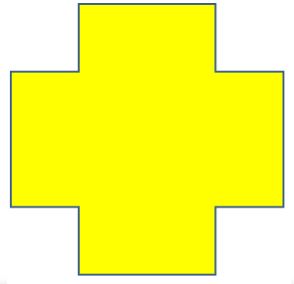
Convex or Concave
OPTIONAL way to determine if a polygons are convex or concave: To check, extend the lines containing each side. If any of the lines contain any point in the interior of the polygon, then it is concave. Otherwise it is convex. The triangle below is convex, while the pentagon is concave.
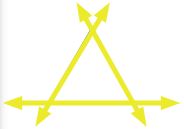
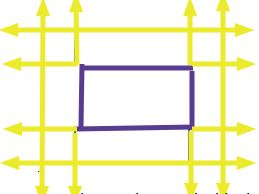
Exercise #1
Identify if the polygons are conves or concave.
 Answer: concave
Answer: concave 
Answer: Convex

Answer: Convex

Answer: Convex

Answer: Concave

Answer: Concave
Names of Polygons
You name a polygon by the number of sides it contains. Use the chart below.
| # of sides | Name |
| 3 | triangle |
| 4 | quadrilateral |
| 5 | pentagon |
| 6 | hexagon |
| 7 | heptagon |
| 8 | octagon |
| 9 | nonagon |
| 10 | decagon |
| 11 | hendecagon |
| 12 | dodecagon |
| n sides | n-gon |
n-gon
Notice the last row has "n" sides. This is primarily used for polygons when the number of sides are greater than 12.
Replace the "n" with the number of sides.
For instance, a polygon with 13 sides would be called a 13-gon.
What would a polygon with 46 sides be called?
Answer: 46-gon
Exercise #2
Identify the polygons by name.

Answer: pentagon

Answer: decagon

Answer: heptagon

Answer: octagon

Answer: quadrilateral
Equilateral and Equiangular
We can also identify a polygon as:
equilateral - all sides congruent

equiangular - all angles are congruent
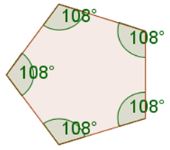
Regular Polygons
If a figure has all sides congruent and all angles congruent then it is called a regular polygon.
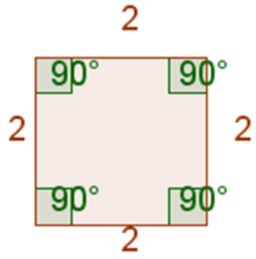
A square is a regular quadrilateral because all four sides are congruent and all four angles are congruent.
Classify Polygons
You can now:
- Classify a polygon as convex or concave
- Name the polygon by the number of sides
- Identify if the polygon is equilateral, equiangular or both - thus regular or neither
Try This One
Classify this polygon:
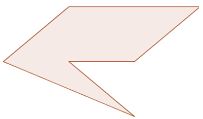
Is it concave or convex?
Answer: Concave
What is the name of this polygon?
Answer: hexagon
Is it equilateral, equiangular, both, or neither?
Answer: neither
Classify Polygons
Look at the figure and see if you can decide who is correct in classifying the polygon.
Chase said convex, regular, quadrilateral.
Anna said convex, equiangular, quadrilateral.
Who is correct and why?
Answer: Anna; The sides are not congruent so it is not regular. Anna is correct.
Vertices of a Polygon Given Lines
Draw a Polygon a Coordinate Plane
To draw a polygon in the coordinate plane given the coordinates of its vertices, first plot the ordered pairs. Then, connect the order pairs with line segments.
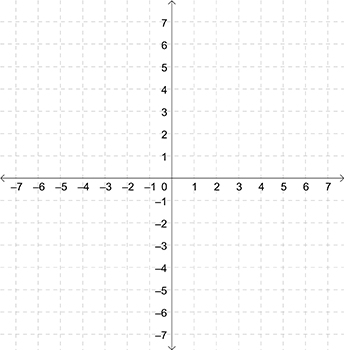
For example, to draw a triangle with coordinates A(0,1), B(2,4) and C(4,3) on the coordinate plane, you will first plot the points A(0,1), B(2,4) and C(4,3) on the coordinate plane.
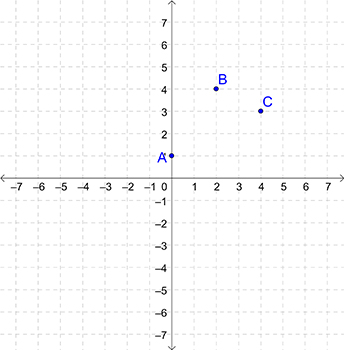
Then, connect the points with line segments.
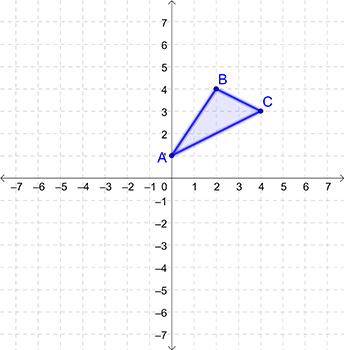
Vertices of a Polygon Given Lines
The vertices of a polygon in a coordinate plane are the points of intersection of the lines that contain the sides of the polygon.
Early in the lesson, you have learned that the vertex of a polygon is where two sides meet or intersect.
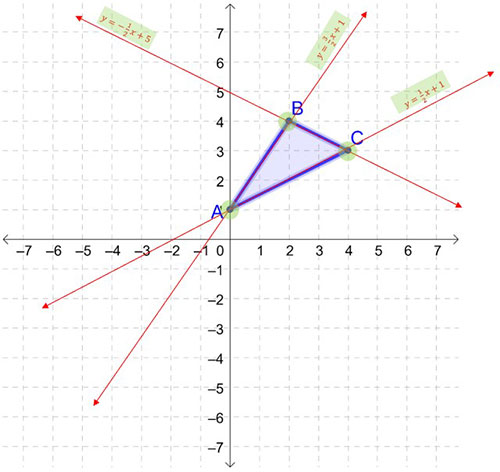
If you are given the equations of the lines that form a polygon in a coordinate plane, you can find the coordinates of the vertices by finding the points of intersection of the lines.
The points of intersection of the lines in the diagram are (0,1), (2,4), and (4,3). So, the vertices of the triangle that is formed by the three lines are (0,1), (2,4), and (4,3).
How to Find the Point of Intersection
The point of intersection of two non-parallel lines can be found by:
Method 1:
- Rewrite the equations of the lines in slope-intercept form (Solve each equation for y).
- Set the two expressions for y equal to each other.
- Solve for the value of the x variable. The value of the x variable is the x-coordinate of the point of intersection.
- Solve for the value of the variable y by substituting the value of the x variable into either of the original equations of the lines. The value of the y variable is the y-coordinate of the point of intersection.
Method 2:
- Graph each equation on the coordinate plane.
- Locate the points of intersection on the graph.
Example #5 Method 1 - Part 1
Find the coordinates of the vertices of the triangle formed by the lines: y = 3x − 8, y = -x + 4, and y = x + 2.
First, find the intersection of the lines: y = 3x − 8 and y = -x + 4.
Step 1: Write the equations of the lines in slope-intercept form (Solve each equation for y).
- Answer: The equations are already in slope-intercept form.
Step 2: Set the two expressions for y equal to each other.
- Answer: 3x − 8 = -x + 4
Step 3: Solve for the value of the x variable. The value of the x variable is the x-coordinate of the point of intersection.

Step 4: Solve for the value of the variable y by substituting the value of the x variable into either of the original equations of the lines. The value of the y variable is the y-coordinate of the point of intersection.
Substitute x = 3 into the first equation, y = 3x − 8.
y = 3x − 8
y = 3(3) − 8
y = 9 − 8
y = 1
So, the point of intersection of the lines, y = 3x − 8 and y = -x + 4, is (3,1).
Example #5 Method 1 - Part 2
Now, find the intersection of the lines: y = 3x − 8 and y = x + 2.
Step 1: Write the equations of the lines in slope-intercept form (Solve each equation for y).
- Answer: The equations are already in slope-intercept form.
Step 2: Set the two expressions for y equal to each other.
- Answer: 3x − 8 = x + 2
Step 3: Solve for the value of the x variable. The value of the x variable is the x-coordinate of the point of intersection.

Step 4: Solve for the value of the variable y by substituting the value of the x variable into either of the original equations of the lines. The value of the y variable is the y-coordinate of the point of intersection.
Substitute x = 5 into the first equation, y = 3x − 8.
y = 3x − 8
y = 3(5) − 8
y = 15 − 8
y = 7
So, the point of intersection of the lines, y = 3x − 8 and y = x + 2, is (5,7).
Example #5 Method 1 - Part 3
Now, find the intersection of the lines: y = -x + 4 and y = x + 2.
Step 1: Write the equations of the lines in slope-intercept form (Solve each equation for y).
- Answer: The equations are already in slope-intercept form.
Step 2: Set the two expressions for y equal to each other.
- Answer: -x + 4 = x + 2
Step 3: Solve for the value of the x variable. The value of the x variable is the x-coordinate of the point of intersection.

Step 4: Solve for the value of the variable y by substituting the value of the x variable into either of the original equations of the lines. The value of the y variable is the y-coordinate of the point of intersection.
y = -x + 4
y = −(1) + 4
y = 3
So, the point of intersection of the lines, y = -x + 4 and y = x + 2, is (1,3).
Example #5 Method 1 - Solution
Solution:
- The point of intersection of the lines: y = 3x − 8 and y = -x + 4 is (3,1).
- The point of intersection of the lines: y = 3x − 8 and y = x + 2 is (5,7).
- The point of intersection of the lines: y = -x + 4 and y = x + 2 is (1,3).
The coordinates of the points (3,1), (5,7), and (1,3) represent the vertices of the triangle that are formed by the lines: y = 3x − 8, y = -x + 4, and y = x + 2.
So, the vertices of the triangle are (3,1), (5,7), and (1,3).
Example #6 Method 2
Watch Find the Coordinates of the Vertices of a Polygon Formed by Lines.
Go to Find the Vertices of a Polygon Given Lines if you would like to practice along with this video.
Open Find the Coordinates of the Vertices of a Polygon Formed by Lines in a new window
Note: The presentation may take a moment to load.